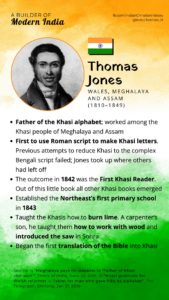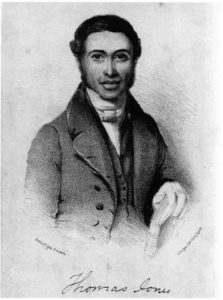By Kyrsoibor Pyrtuh
 June 22, 1841, is considered as the watershed moment in the field of education in the Land of Hynniewtrep, which comprises the Khasi & Jaintia Hills region. The date marked the arrival of Thomas Jones, who subsequently revived and advanced the introduction of the school education system that had been initiated earlier by the Serampore Mission.
June 22, 1841, is considered as the watershed moment in the field of education in the Land of Hynniewtrep, which comprises the Khasi & Jaintia Hills region. The date marked the arrival of Thomas Jones, who subsequently revived and advanced the introduction of the school education system that had been initiated earlier by the Serampore Mission.
Alongside the propagation of the Gospel, Welsh Calvinistic Methodist Presbyterian mission had significantly reshaped the region’s educational and literary ecosystem. Since 1842 and with the establishment of three Lower Primary Schools at Mawmluh, Mawsmai and Sohra Twa, the Welsh mission had accelerated the process of educating the indigenous people with modern education. The arrival of the Catholic Mission in 1890, further contributed to its progress. Moreover, indigenous stalwarts such as Rash Mohan Nongrum and Jeebon Roy Mairom also played a vital role in promoting education. Their efforts included establishing schools, publishing literature and contributing to the growth of Khasi written and spoken language.
Monetisation of “U Khaw Kham” and the spread of Primary Education:
 The establishment of Lower Primary Schools across the Hynniewtrep region is associated with the concept of “U Khaw Kham.” “U Khaw Kham,” literally translated as “a handful of rice,” refers to the practice whereby members of the Methodist Presbyterian Church set aside a portion of rice daily to support the propagation of the Gospel and the establishment of primary schools.
The establishment of Lower Primary Schools across the Hynniewtrep region is associated with the concept of “U Khaw Kham.” “U Khaw Kham,” literally translated as “a handful of rice,” refers to the practice whereby members of the Methodist Presbyterian Church set aside a portion of rice daily to support the propagation of the Gospel and the establishment of primary schools.
Although the idea of “U Khaw Kham” did not originate from the Hynniewtrep region, its propagation was led by indigenous members of the Methodist Presbyterian Church, namely Babu Kat Pde and Babu Joel Gatphoh, during the early 20th century. The movement began at the Mawkhar Presbyterian Church in Shillong, inspired by a story shared by Dr. Nelee Bronson, a Baptist missionary in Garo Hills, during his visit. In his sermon, he recounted how Garo Christians set aside and sanctified a portion of rice to support evangelists, pastors and preachers of the Gospel. This story captivated and inspired Babu Kat Pde, Babu Joel Gatphoh, and other church elders.
 The “U Khaw Kham” or handful of rice is an offering to be sanctified to the Lord. Members of the Presbyterian Church would set aside a handful of rice both in the morning and evening from their family’s earnings as an offering to God. This offering or collection was then converted into monetary value and contributed towards church missions to sustain the lives and work of evangelists, pastors, preachers and school teachers.
The “U Khaw Kham” or handful of rice is an offering to be sanctified to the Lord. Members of the Presbyterian Church would set aside a handful of rice both in the morning and evening from their family’s earnings as an offering to God. This offering or collection was then converted into monetary value and contributed towards church missions to sustain the lives and work of evangelists, pastors, preachers and school teachers.
Babu Joel Gatphoh and other church elders found this idea compelling. Given the poverty among native Khasi Christians and their limited financial resources then, they believed it fitting to replicate the practice of setting aside a portion of rice. The collected rice would be monetised and channelled to support evangelists, preachers and teachers across the region.
When Babu Joel Gatphoh was appointed as a sub-inspector of schools, he actively propagated the idea of “U Khaw Kham,” urging adherents across the region to set aside rice to support mission work. Prior to the revival of 1905, Babu Kat Pde and Babu Joel Gatphoh were committed to educating and sensitising church members about the importance of contributing a handful of rice for mission support. Although initial efforts faced setbacks and the movement was temporarily discontinued. From 1907-1908 onward, the movement gained momentum and the first collection of “U Khaw Kham” took place in Sohrarim in 1907, with proceeds given to the Home Mission. Similarly, collections were made in Jaintia Hills during the same year and from 1908, the “U Khaw Kham” movement spread throughout the Khasi and Jaintia Hills.
In Mawkhar Presbyterian Church, Shillong, regular collections began in 1908. That year, about thirteen families and several hostellers from the former Welsh Mission School for Girls contributed to the “Khaw Kham” basket. This rice was monetised, generating an amount of Rs 10-6-0 or ten rupees and six annas, which was used to establish the first “Khaw Kham” schools at Shynturbulia and Korhadem in Ri Bhoi. Over the course of five decades, the collection and monetisation efforts in Mawkhar Presbyterian Church alone increased exponentially, from Rs. 3,248.96 in 1956 to Rs. 2,45,181.00 in 2006. The primary purpose of collecting and monetizing “U Khaw Kham” was to establish schools, but the funds have also been used to support the poor and destitute, and to provide healthcare and medications for marginalised members of the church.
Provincialization of Education in Meghalaya:
Meghalaya Education Department’s consultative paper presented in May 2025, had laid bare many challenges that hinder the systematic growth of education in the State. It was argued that under-enrolled schools, fragmented administrative structures and complex funding systems have contributed to low ranking at national performance grading index. To counter these challenges the State’s Education Department is proposing to consolidate the Multiple Grant in Aid Schemes for educational institutions in the State and to bring them under a unified scheme, the Meghalaya Education Grant (MEG) with the objective of streamlining funding and to improve the quality and governance of education without reducing existing financial support. The MEG entails a litany of core principles to be adhered to as soon as it is approved. The State had solicited public opinions (which I believed that educators, policy and opinion makers have made their presentations) in this regard.
In Meghalaya credit must be given to various missions or faith-based organisations for the growth of education. In the early years of the 20th century wherever the Gospel was preached, lower primary schools were set up by Presbyterian, Catholic and Baptist missions in their respective areas of operation. However, the situation has vastly changed and today the mission’s managed educational institutions are being substantially supported and funded by the State by way of deficit and grant in aid systems et al. As per new study reports, Meghalaya saw a rise of literacy rate to 94 % and it is revealed that the State has 14,582 schools with 7,783 government schools and 4172 aided schools and there are a total number of 55,160 teachers in Meghalaya. It is against this backdrop that the State’s education department is pushing for MEG and the undoing of deficit and other archaic practices in the education system.
In Meghalaya the education system is divided into several categories of management, namely, Government, Deficit, Ad-hoc and private run institutions. The issue or rather the attempt of the State to bring them under one form of administration and funding dated back to 1988 when the Government of Meghalaya had published the White Paper in conjunction with the National Education Policy of 1986. In 2013 the Government had pronounced to provincialise those deficit schools which were not run by religious institutions and today the consultation is on to provincialise all Deficit Schools in the State.
Provincialisation of schools is the process by which the government takes over the management and funding of privately owned or community-run or faith-based schools, bringing them under the public education system. This process aims to standardize education, ensure quality and make education accessible and affordable for all. Perhaps, Meghalaya is encountering major roadblocks as most mission run schools may not be willing to hand over the management. These mission managed schools may have reasonable arguments to be averse to the idea of handing over the management. Undoubtedly, some of the mission run schools are better managed, while others have their own systemic failures and over several decades they have failed to rectify, which in turn adversely affect the advancement of education and introduction of new knowledge.
A few teachers have expressed that provincialisation has its own advantages and disadvantages. To be fully funded by the government in terms of salaries, infrastructure, is a step in the right direction. However, most privately owned schools are church-established institutions and perhaps (if not all) may not agree to this. If they do not agree, it means that all responsibilities and management will fall solely on them, which could perhaps lead to continued irregularities and mismanagement issues, potentially hindering the growth of learning and education.
Teachers the Backbone of State/Nation:
It is ritualistic for policy makers and peoples’ representatives to utter this common chant “the teachers are the backbone of the State/Nation. This is done only to placate or flatter the teachers and it is one strategy for the State to hide its apathy towards the pivotal section of workers, i.e. the educators or teachers.
In Meghalaya, the teachers are engaging in back breaking work with low wages and they should no longer listen to the platitudes which are alluring, but disrespectful to their dignity. For the teachers to be able to contribute to Nation building, they must be treated justly and fairly in every aspect. The Government must immediately provide a living wage to all teachers, implement the equal pay for equal work, raise the salary of all teachers as per law and by law institute a Private School Regulatory body and protect the private school teachers against exploitations.



